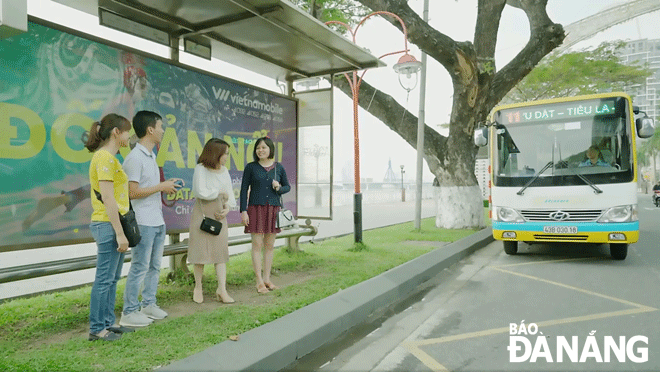Da Nang's efforts to attract more bus passengers
With the goal of developing a public transport system, limiting personal vehicles, and reducing pressure on transport infrastructure, since October 2016, Da Nang has launched 12 subsidised intra-city bus routes.
 |
| Passengers waiting for a subsidised bus |
However, there are now four subsidised intra-city bus routes operating in the city with a total of 26 buses. They are the routes R16: Kim Lien - Viet Nam-Korea Information Technology and Communications University, R17A: Song Han Port - Hoa Vang District Administrative Centre, R4A: Song Han Port - Hoa Tien Commune, and R6A Da Nang Coach Station - Marble Mountains Tourist Area.
The reason cited for the decrease in the number of subsidised bus routes is low passenger demand.
As shared by many residents, they have got into the habit of using personal motorbikes, whilst the bus network is not yet widespread and evenly distributed in some areas.
Additionally, some bus stops are even farther than 500m, and sidewalk areas for pedestrians to access buses are not convenient.
The number of bus passengers has reached more than 13 million over the past 5 years, and this figure has been uneven. Some bus routes have recorded an impressive number of passengers, whilst others have reported a low number of passengers.
In its effort to overcome the current inadequacies, the municipal Department of Transport plans to make adjustments to some inappropriate bus routes, and target groups of bus passengers who are in high demand such as students, pupils, tourists and workers working outside the city centre.
Also, importance will be attached to raising public awareness about the positive impact and environmental benefits of public transport services.
Currently, the municipal Department of Transport has taken many measures to limit personal motor vehicles and separate traffic flows in the city.
Simultaneously, the department will work with schools to control the situation of pupils riding motorbikes to school, and mobilise workers to go to work by bus instead of personal vehicles.
In the long term, the city will continue to launch more bus routes, shorten the distance between bus stops to 100-200m, and change 1 or 2 bus routes to facilitate passengers.
Moreover, heed will be placed on increasing access to tourist attractions, as well as connecting bus routes with each other, bus stops and main transport hubs such as airports and train station.
In addition, the focus will be on reviewing and rearranging bus stops at tourist attractions, and setting up bus transit points to connect public passenger transport services together, thereby helping passengers transfer bus routes easily.
Along with that, the department will regularly monitor subsidised bus routes through the journey monitoring devices installed on buses to handle violations of skipping stops, and running wrong routes.
Reporting by THANH LAN - Translating by M.DUNG